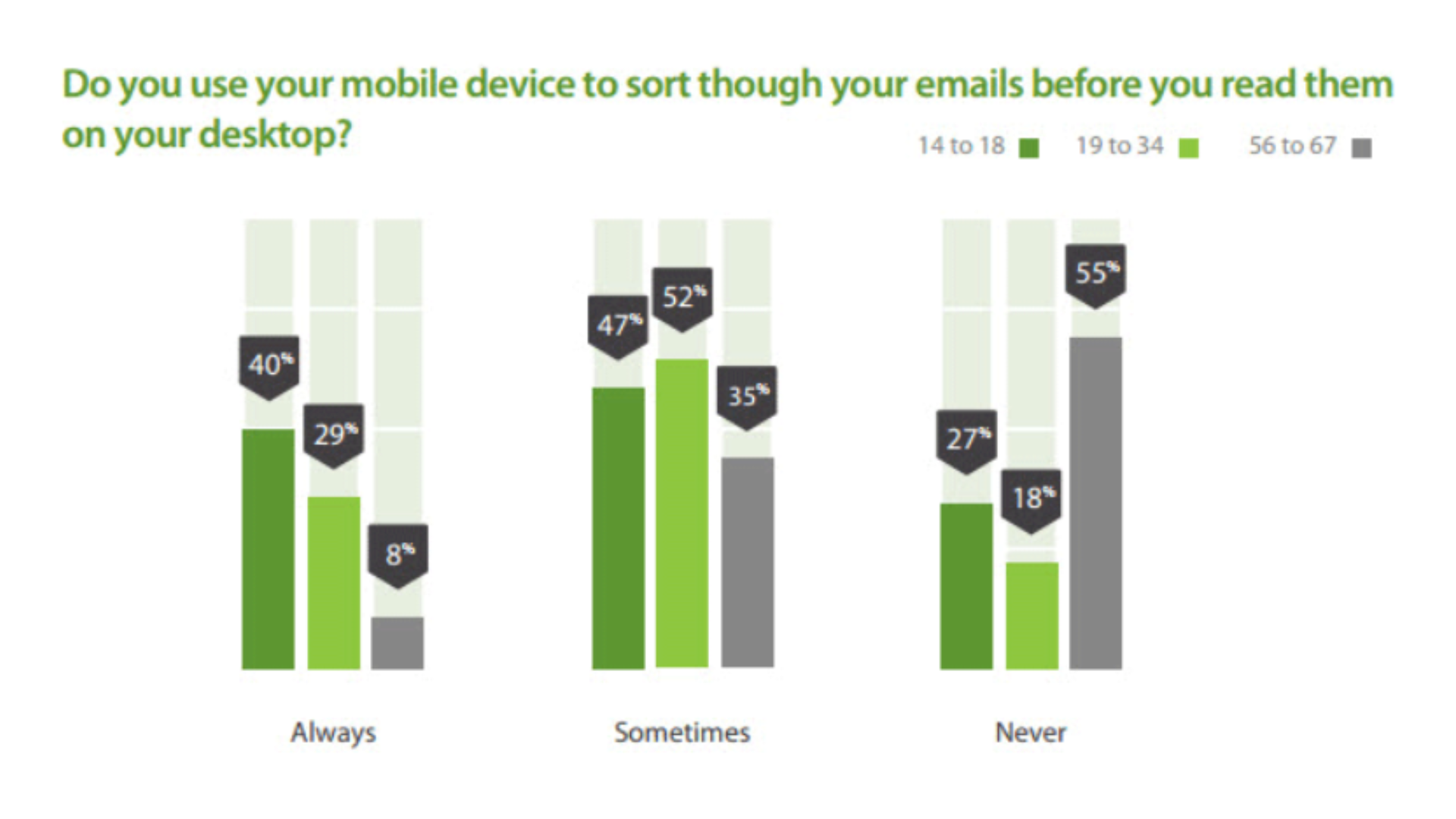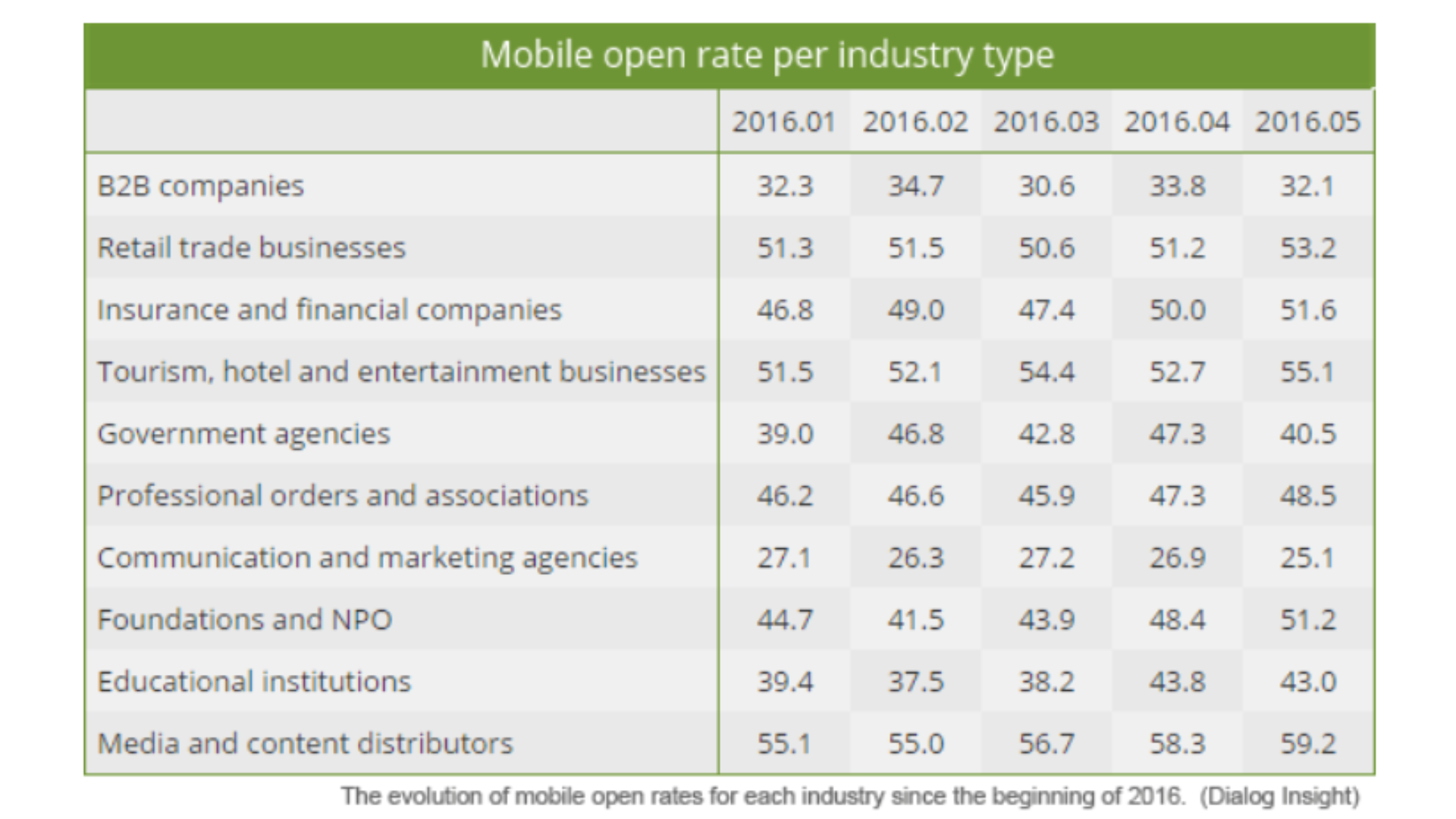- blog
- Statistics
- Mobile Email Statistics 2025: Key Data & Trends You Need

Mobile Email Statistics: The Complete Guide to Mobile-First Email Marketing in 2025
Table of Contents
Picture this: You craft the perfect email campaign, hit send, and wait for the engagement to roll in. But here’s the reality check – 75% of people use their smartphones most often to check email, and if your emails aren’t optimized for mobile, you’re basically throwing money down the drain.
The mobile revolution has completely transformed how people interact with their inboxes. What started as a desktop-dominated activity has now shifted dramatically, with smartphones becoming the primary gateway to email for billions of users worldwide.
Whether you’re a BDR trying to book more meetings or an AE looking to close deals faster, understanding mobile email statistics isn’t just helpful – it’s essential for your success. Let’s dive into the data that’s shaping email marketing in 2025.
Usage and Growth of Email on Mobile
The numbers don’t lie – mobile email has taken over. Mobile clients account for 41.6% of email opens, followed by webmail opens at 40.6% and desktop opens at 16.2%. This shift represents one of the most significant changes in digital communication behavior we’ve seen in the past decade.
But it gets even more impressive when you look at the global scale. Nearly 4.5 billion people use email worldwide in 2025, and this number is projected to reach over 4.8 billion by 2027. That’s more than half the world’s population actively using email, with the vast majority checking it on their phones.
The Daily Email Habit
The frequency of mobile email checking is staggering. 88% of email users check their inbox multiple times a day, with 39% checking it 3-5 times daily. 58% of email users check their emails first thing in the morning before looking at social media or anything else online.
This behavior creates an incredible opportunity for marketers and sales professionals. When someone opens your email on their phone first thing in the morning, you’ve got their undivided attention – at least for those crucial first few seconds.
Volume and Scale
The sheer volume of emails being sent is mind-boggling. By 2025, roughly 376.4 million emails will be sent daily, with It’s forecasted to increase further by a similar margin in 2025, hitting 361.6 billion daily emails.
Here’s what makes this even more significant: Mobile devices account for at least 50% of all read emails since users can easily check their inboxes while on the road using gadgets like smartphones and tablets.
Generational Differences
The generational divide in mobile email usage is striking. 59% of Millennials primarily use their smartphone to check email, while 67% of Generation Z scans their inbox on mobile. If your target audience includes younger professionals, mobile optimization isn’t optional – it’s mandatory.
Interestingly, 81% of Gen Z members check their email at least once a day, proving that email isn’t dead among younger generations – it’s just moved to mobile.
💡 Quick Win for Cold Email Success
Use Salesso to optimize your mobile outreach! Find verified email addresses, warm up your inboxes, and send mobile-optimized cold emails that get results.
[Try Free →]
Mobile Email Statistics per Industry
Different industries see varying levels of mobile email engagement, and understanding these patterns can help you benchmark your performance and set realistic expectations.
B2B vs B2C: The Great Divide
The difference between B2B and B2C mobile email engagement is significant. B2C emails get 57.4% more opens on mobile than B2B email, ranking 42.78% opens on mobile for B2C compared to 27.18% for B2B.
This doesn’t mean B2B professionals aren’t using mobile – they absolutely are. 35% of business professionals view their emails on mobile devices, and 61% of B2B emails are first opened on mobile devices. The key difference is that B2B buyers often use mobile for initial screening, then switch to desktop for detailed review and action.
Industry-Specific Performance
Mobile email performance varies dramatically across industries:
- Leisure, Sports & Recreation: Up to 60% mobile readership – the highest among all sectors
- Schools & Education: Around 38.2% mobile readership – lower than average
- E-commerce: High mobile engagement, especially during shopping events
- Healthcare: Strong mobile adoption for appointment reminders and health updates
- Financial Services: Security-conscious users but growing mobile adoption
B2B Mobile Email Behavior
77% of B2B buyers prefer that people contact them via email, making it the preferred contact method. However, B2B mobile email behavior has unique characteristics:
- Decision-makers often triage emails on mobile during off-hours
- Complex decisions still typically move to desktop
- C-level executives frequently check emails between 6 AM and 9 AM on mobile
- B2B marketing emails have a 23% higher click-to-open ratio compared to B2C marketing emails
Mobile Email Statistics per Country
Global mobile email usage shows fascinating regional variations that reflect infrastructure development, cultural preferences, and device adoption rates.
Regional Performance Breakdown
- North America: 45.30% average open rate with 4.77% CTR – high smartphone penetration drives strong mobile engagement
- Oceania: 55.66% open rate but only 2.48% CTR – high initial engagement but conversion challenges
- Europe: 43.25% open rate with 3.58% CTR – diverse market with GDPR considerations
- Asia: 28.04% open rate but impressive 4.06% CTR – lower opens but higher engagement when users do interact
Mobile Infrastructure Impact
Countries with advanced mobile infrastructure and high smartphone penetration consistently show higher mobile email engagement rates. The rollout of 5G networks is expected to further boost mobile email performance by enabling richer content and faster load times.
Cultural Considerations
Cultural preferences significantly impact mobile email behavior:
- Some regions prefer SMS for urgent communications
- Business cultures vary in email formality expectations
- Time zone differences affect optimal send times
- Language and localization affect mobile display effectiveness
When and Where Do We Check Our Email?
Understanding the context of mobile email consumption is crucial for timing your campaigns and designing your content appropriately.
The “Always On” Mobile Reality
About 3 in 5 consumers check their email on the go (mobile), creating a completely different engagement context than desktop email checking. People read emails while:
- Commuting to work
- Waiting in line
- During TV commercial breaks
- In bed before sleep
- Walking between meetings
- During lunch breaks
Peak Mobile Email Times
The data reveals specific patterns in mobile email checking:
- Early Morning (6-9 AM): High engagement, especially among executives
- Lunch Hours (12-2 PM): Quick scans and triage
- Evening Commute (5-7 PM): Catch-up and personal email
- Before Bed (9-11 PM): Final inbox check of the day
Work vs Personal Email Patterns
Work-related email is 40% less likely to be checked on a smartphone compared to personal email (35% for work versus 59% for personal). This suggests that while professionals use mobile for email, they’re more selective about engaging with work content on smaller screens.
Attention Span Reality
The mobile context creates unique challenges for marketers. The average time people spend reading an email is 10 seconds, and this is likely even shorter on mobile devices where distractions are constant.
42.3% of users delete emails that are not optimized for mobile devices, giving you an incredibly narrow window to make a good impression. 50% of people will delete an email if it isn’t optimized for mobile.
🚀 Maximize Your Mobile Email Success
Salesso’s Advanced Email Platform Find prospects, verify emails, and send campaigns that work perfectly on mobile devices.
[Get Started]
Mobile Email Conversion, Revenue and Purchases
This is where mobile email marketing really shows its power. The conversion and revenue data proves that mobile email isn’t just about engagement – it’s about driving real business results.
Direct Revenue Impact
The financial impact of mobile email is substantial. Mobile revenue has been reported to account for 20% of all email-generated revenue, and this figure grew significantly year-over-year.
During peak shopping periods, mobile email’s power becomes even more apparent. During holiday seasons, 47% of online sales are transacted via smartphones, with a significant portion of these purchases initiated through email campaigns.
Mobile Email ROI Excellence
Email marketing already delivers exceptional ROI, with The average expected ROI is $42 for every $1 you spend on email marketing. When you optimize for mobile, this ROI gets even better.
Mobile-optimized emails generate 15% higher conversion rates compared to non-optimized ones. For businesses hesitant about investing in mobile optimization, this 15% conversion lift provides clear financial justification.
Purchase Behavior Patterns
Mobile email drives different types of purchase behavior:
- Immediate Purchases: 50% of consumers have made a purchase through a mobile website after viewing a marketing email
- App-Based Purchases: 24% have made purchases via smartphone apps
- Cross-Device Journey: 31% of consumers report waiting until they are on a PC or laptop to complete the transaction
Conversion Rate Benchmarks
Understanding mobile email conversion benchmarks helps set realistic expectations:
- Average Email Conversion Rate: The average conversion rate for email marketing is between 2 and 5%
- Industry Variations: Conversion rates vary significantly by industry and email type
- Automated Email Performance: On average, automations get 42.1% open rate, a 5.4% click rate, and a 1.9% conversion rate
B2B Mobile Conversion Impact
In B2B contexts, mobile email quality has long-term consequences. 90% of B2B buyers who have a positive mobile experience are likely to make a repeat purchase from the same vendor, compared to just 50% for those with poor mobile experiences.
Abandoned Cart Mobile Recovery
Mobile email excels at recovering abandoned purchases. Abandoned cart email campaigns have an open rate of 50.50%, and Businesses earn an average of $3.45 in revenue per abandoned cart email recipient.
Mobile Email Optimization
Getting mobile email optimization right isn’t just about making emails look good on small screens – it’s about creating experiences that drive engagement and conversions in mobile contexts.
Responsive Design Fundamentals
Businesses see a 15% increase in mobile clicks when creating a mobile-responsive email design. This isn’t just about aesthetics – responsive design directly impacts your bottom line.
Key responsive design principles include:
- Single-column layouts that work on narrow screens
- Scalable images that load quickly
- Touch-friendly buttons and links
- Readable fonts without zooming
Subject Line Optimization for Mobile
Mobile devices display fewer characters in subject lines, making every word count. Best practices include:
- Keep subject lines under 50 characters (ideally 30-35)
- Front-load the most important information
- Use personalization when relevant
- Test different lengths for your audience
Content Strategy for Mobile Readers
Mobile email content needs to be scannable and actionable:
- Brevity: Keep emails short and focused
- Hierarchy: Use headers and bullet points to break up text
- White Space: Give content room to breathe on small screens
- Clear CTAs: Make action buttons obvious and easy to tap
Technical Optimization
Technical performance is crucial for mobile email success:
- Load Speed: Optimize images and minimize file sizes
- Testing: Test across different devices and email clients
- Dark Mode: Ensure emails work in both light and dark themes
- Accessibility: Include alt text and maintain good contrast ratios
Mobile-Specific Design Elements
Consider mobile-specific design choices:
- Larger fonts (minimum 14px for body text)
- Thumb-friendly button sizes (minimum 44×44 pixels)
- Simplified navigation
- Swipe-friendly layouts where appropriate
📧 Perfect Your Mobile Email Strategy
Get professional mobile-optimized templates with Salesso. Every email automatically adapts to any device for maximum engagement.
[Start Free Trial]
Historical Mobile Email Statistics
Looking at historical trends helps understand where mobile email is heading and how dramatically the landscape has changed.
The Mobile Transition Timeline
The shift to mobile email didn’t happen overnight:
- 2010-2015: Desktop dominated email opens (70%+ desktop)
- 2016-2020: Mobile reached parity with desktop
- 2021-2025: Mobile became dominant platform (40%+ of opens)
Key Milestone Statistics
Several statistics mark important turning points:
- 2018: Mobile email opens first exceeded desktop opens consistently
- 2020: COVID-19 accelerated mobile email adoption
- 2022: Mobile email conversion rates began matching desktop rates
- 2024: Mobile-first design became standard practice
Evolution of User Behavior
Historical data shows changing user behaviors:
- Email checking frequency increased with smartphone adoption
- Younger generations adopted mobile email faster
- Business professionals gradually shifted from desktop-primary to mobile-first
- Cross-device email journeys became more common
Technology Impact
Several technological developments shaped mobile email:
- Improved Mobile Networks: 4G and 5G enabled richer email content
- Better Email Clients: Apps improved rendering and functionality
- Responsive Design: Became standard practice rather than nice-to-have
- AMP for Email: Introduced interactive elements for mobile
Looking Forward
Historical trends suggest several future developments:
- Mobile email opens will continue growing
- Interactive content will become more common
- AI will personalize mobile experiences
- Cross-device integration will improve
Conclusion
The mobile email revolution is complete – and the winners are those who’ve adapted their strategies to meet users where they are: on their smartphones. With 75% of people using smartphones most often to check email and mobile-optimized emails generating 15% higher conversion rates, the business case for mobile-first email marketing is undeniable.
The statistics paint a clear picture: mobile email isn’t just a trend – it’s the new standard. Whether you’re a BDR prospecting for new leads or an AE nurturing existing relationships, your success depends on delivering exceptional mobile email experiences.
The key takeaways are straightforward:
- Mobile dominates email opens across most industries and demographics
- Mobile users are impatient – you have seconds to make an impression
- Optimization pays off with measurably higher conversion rates
- B2B buyers use mobile differently than B2C consumers, but they still use it
- Regional and industry variations require tailored approaches
The businesses thriving in 2025 are those that’ve embraced mobile-first email marketing. They understand that a poorly optimized mobile email isn’t just a missed opportunity – it’s a damaged relationship with a potential customer.
As email marketing continues evolving, one thing remains constant: the importance of meeting your audience where they are, with content that works seamlessly on the devices they use most. In today’s world, that device is overwhelmingly mobile.
Frequently Asked Questions
What percentage of emails are opened on mobile devices in 2025?
How much more revenue do mobile-optimized emails generate?
What's the average time people spend reading emails on mobile?
Do B2B buyers really use mobile for email?
What happens if emails aren't optimized for mobile?
Which generation uses mobile email the most?
What's the ROI of email marketing in 2025?
How often do people check email on their phones?

Find Quality Leads in Just One Click
Install SalesSo’s Chrome Extension and start collecting leads while you browse your favorite sites
